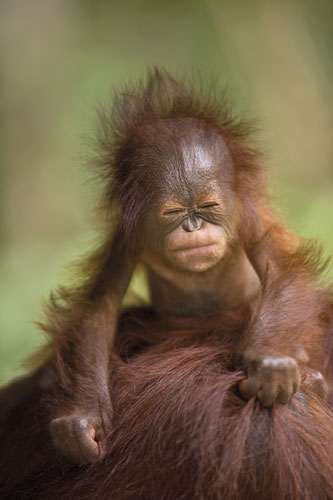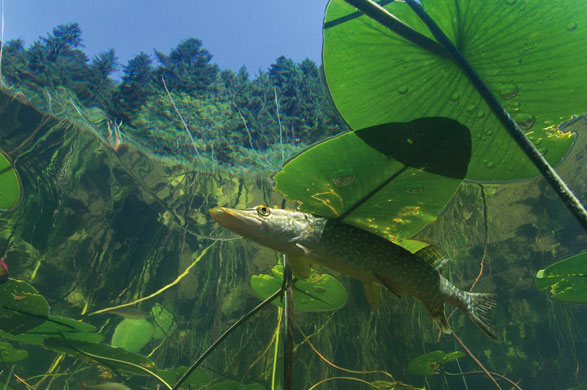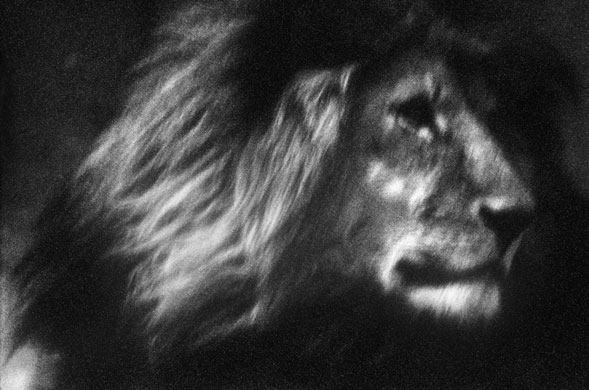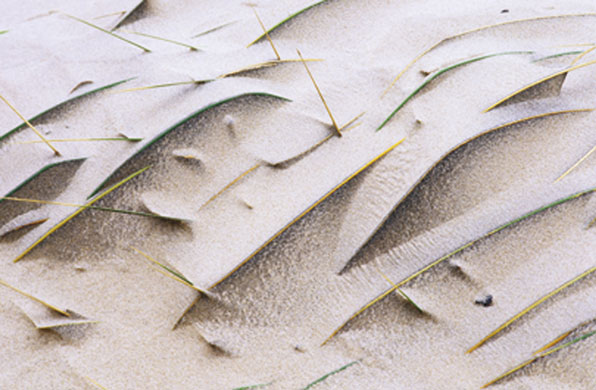
Borneo baby by Brian Matthews (United Kingdom)
The baby could have been only a couple of months old, but its mother was used to the orang-utan researchers and was comfortable for them to watch her from about five metres (16 feet) away. Brian was working with the researchers in Tanjung Putting national park, Kalimantan (Indonesian Borneo), photographing wild orang-utans in the rainforest. When the infant stuck its tongue out, scrunched up its face and blinked, ‘it was impossible not to be reminded of a human baby,’ he said.
Canon EOS-1Ds Mark II + Canon 300mm f2.8L USM IS lens; 1/250 sec at f2.8; ISO 200 (-1 1/3 stop); fill-flash Photograph: Brian Matthews/Veolia Environnement Wildlife Photographer of the Year 2009

Pike perfection by Michel Loup (France)
Photographs in this category must create a sense of place and convey a feeling of the relationship between an animal and where it lives, the judges say. A blue sky, sun filtering down, a pike hanging peacefully beneath water lilies, a glimpse of trees on the lakeshore in the Jura (France) – the perfect summer scene. Michel set out to create this composition, ‘avoiding the photographic cliché of a half-air, half-water shot’. But going from theory to reality was a huge learning curve. He had countless unsuccessful attempts before being able to master this low-angle image. ‘But thanks to digital technology,’ he says, ‘I developed the right reflexes and was prepared when everything came together’ – beautiful lighting, gin-clear water, a smooth surface, the perfect foreground and background and, of course, an obliging pike Photograph: Veolia Environnement Wildlife Photographer of the Year 2009

Intimate death by Miles Kenzo Kooren (Netherlands)
Thud! Something fell out of a tree and landed on the sand near where Miles and his sister were cooling off in a lagoon in the Lambir Hills national park, Sarawak, Borneo. A small snake was wrapped tightly around a gecko. ‘Paradise tree snakes can kill small prey, but they’re not dangerous to humans,’ says Miles, who lay really close on the ground and photographed the whole meal. ‘It took so long for the snake to swallow its prey,’ says Miles, ‘that I was able to take lots of pictures’
Canon EOS-5D + 70-200mm lens; 1/500 sec at f6.3; ISO 250 Photograph: Miles Kenzo Kooren/Veolia Environnement Wildlife Photographer of the Year 2009

Lone lion by Britta Jaschinski (Germany)
Photographs in this category must display a skilful and artistic use of the black-and white medium. The subject can be any wild landscape or creature. Britta heard tales of a solitary old lion wandering in the Lobo area of Tanzania’s Serengeti national park. Fascinated, she spent three days searching for him and found him resting in the shade of an acacia tree. No one was sure what had happened to him, though he may have been forced from his pride by a younger male. ‘His face seemed to bear the weight of wide experience. An old, wise beast. Enormously powerful, but lost perhaps – for a moment – in his own solitude.’
Nikon FG + 200mm lens; 1/250 sec at f5.6; Polaroid 35mm high-contrast black-and-white instant film ISO 400 Photograph: Britta Jaschinski/Veolia Environnement Wildlife Photographer of the Year 2009

Beach-grass sandscape by Mariusz Oszustowicz (Poland)
The aim of this category is to showcase the beauty and importance of flowering and non-flowering plants and fungi, whether by featuring them in close-up or as part of their environment. The storm that hit the coastal dunes of Poland’s Slovinski national park had been so strong that Mariusz had had difficulty just standing up, and his camera had filled with sand. Walking through the moonscape of the now-still dunes, Mariusz came across a magical valley. The marram grass had been buried by sand and sprinkled with frost, the texture and colours enhanced by an overcast sky, creating an unforgettable scene.
Olympus OM-4Ti + Olympus Zuiko 100mm f2.8 lens; 1/60 sec at f5.6; Fujichrome Velvia 50; Manfrotto 441 tripod Photograph: Mariusz Oszustowicz/Veolia Environnement Wildlife Photographer of the Year 2009







